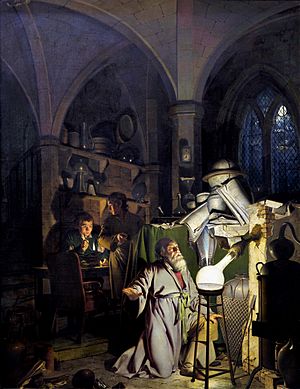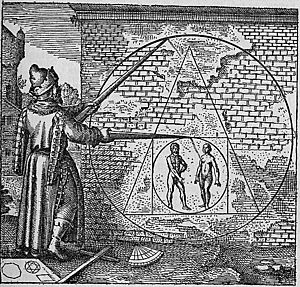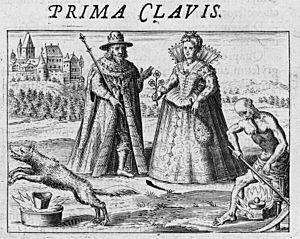Philosopher's stone facts for kids

The philosopher's stone is a legendary substance from alchemy. People believed it could turn ordinary metals, like mercury, into gold or silver. It was also thought to be an elixir of life, meaning it could make people young again and even help them live forever! For many centuries, finding this stone was the main goal for alchemists.
The philosopher's stone was a very important symbol in alchemy. It stood for perfection, wisdom, and great happiness. The search for it was called the Magnum Opus, or "Great Work."
Contents
History of the Stone
Ancient Ideas
The first known mention of the philosopher's stone in writing was around 300 AD. It was in a book called Cheirokmeta by Zosimos of Panopolis. Some alchemists believed its history went back even further, to Adam. They thought Adam learned about the stone directly from God. This knowledge was then passed down through important figures in the Bible, which supposedly helped them live for a very long time.
The idea of the stone also came from ancient Greek philosophy. Alchemists used ideas like the classical elements (earth, air, fire, water) and the concept of anima mundi (world soul) to explain how the stone could be made. They also used stories about creation, like those in Plato's Timaeus.
Plato believed that the four elements came from a common source called prima materia (first matter). This was linked to chaos. Alchemists used "prima materia" as the name for the starting material needed to create the philosopher's stone. This idea was very important throughout alchemy's history.
Middle Ages Discoveries
In the early Middle Ages, alchemists in the Byzantine and Arab empires continued the work of Zosimos. They were very interested in changing one metal into another.
An important Muslim alchemist named Jabir ibn Hayyan (also known as Geber) lived in the 8th century. He thought about each classical element based on four basic qualities:
- Fire was hot and dry.
- Earth was cold and dry.
- Water was cold and moist.
- Air was hot and moist.
He believed that every metal was a mix of these four qualities. So, he reasoned that if you could rearrange these qualities, you could change one metal into another! This change would happen with the help of a special substance. It was called xerion in Greek and al-iksir in Arabic. This is where the word elixir comes from. This substance was often described as a dry, red powder. It was thought to be made from the legendary philosopher's stone.
However, not everyone believed in transmutation. In the 11th century, a Persian scholar named Avicenna said that changing one substance into another was not truly possible. He thought alchemists could only make it *look* like a change happened.
Legend says that the scientist and philosopher Albertus Magnus found the philosopher's stone in the 13th century. He didn't write that he found it, but he did say he saw gold being made by "transmutation."
Renaissance to Modern Times

In the 16th century, a Swiss alchemist named Paracelsus believed in a substance called alkahest. He thought it was a basic element from which all other elements (earth, fire, water, air) came. Paracelsus believed this alkahest was actually the philosopher's stone.
A mysterious book from the 17th century, called the Mutus Liber, seems to be a guide for making a philosopher's stone. It was known as the "wordless book" because it had 15 pictures instead of words.
In Eastern Traditions
The idea of the philosopher's stone also exists in Buddhism and Hinduism. There, it is called the Cintamani, or sometimes Paras/Parasmani.
In Mahayana Buddhism, the Chintamani is held by wise beings called bodhisattvas. It is also shown on the back of the Lung ta (wind horse) on Tibetan prayer flags. Buddhists believe that by using the Chintamani, one can gain wisdom and turn problems into good things.
In Hinduism, the Cintamani is linked to the gods Vishnu and Ganesha. It is often shown as a wonderful jewel. The Yoga Vasistha, an ancient Hindu text, tells a story about the philosopher's stone.
A great Hindu sage named Sant Jnaneshwar (1275–1296) wrote about spiritual achievement using the idea of the philosopher's stone. He mentioned it 17 times, saying it could turn ordinary metal into gold. Another sage, Thirumoolar, wrote in the 7th century that the name of God, Shiva, could turn the body into immortal gold.
Another version of the stone is the Shyāmantaka Mani. In Hindu stories, this is a ruby that can prevent natural disasters like droughts and floods. It is also said to produce a lot of gold every day.
What the Stone Could Do
The most common powers of the philosopher's stone were:
- Turning basic metals into gold or silver.
- Healing all sicknesses.
- Making anyone who drank a small part of it (mixed in wine) live longer.
Other powers mentioned include:
- Creating lamps that burn forever.
- Changing common crystals into valuable gems and diamonds.
- Bringing dead plants back to life.
- Making glass that could bend.
- Creating a clone or a tiny human-like creature called a homunculus.
Many Names for the Stone
The philosopher's stone had many secret names. These names were used to hint at the stone without saying its real name. Some examples include "white stone," vitriol, "our stone," "hidden stone," and "water at the box." It was also called by names like Adam, Animal, Antimonium, Chaos, Cerberus, Phoenix, and "Philosophic mercury."
Many old Christian stories about Christ were also used to describe the stone. In a mystical way, Christ and the stone were sometimes seen as the same thing.
How it Looked
People described the philosopher's stone in many different ways. Alchemical texts often said there were two types:
- A white stone, used for making silver.
- A red stone, used for making gold. The white stone was seen as a less finished version of the red one.
The red stone was often described as orange (like saffron) or red when it was a powder. In its solid form, it was said to be a mix of red and purple, clear like glass. It was thought to be heavier than gold, able to dissolve in any liquid, and would not burn in fire.
Some alchemists suggested that these descriptions were not meant to be taken literally. They were metaphors. For example, in a book called Atalanta Fugiens (1617), the stone's appearance is described using shapes: "Make of a man and woman a circle; then a quadrangle; out of this a triangle; make again a circle, and you will have the Stone of the Wise." This was a symbolic way of talking about combining different ideas or elements.
How it Was Made
The philosopher's stone was created using an alchemical method called The Magnum Opus, or "The Great Work." The steps for making the stone were described in different ways. Sometimes, they were shown as a series of color changes:
- Nigredo (blackness)
- Albedo (whiteness)
- Citrinitas (yellowness)
- Rubedo (redness)
Other times, the process was described as a series of chemical steps. These often included seven or twelve stages, ending with "multiplication" (making more of the stone) and "projection" (using the stone to change metals).
The Stone in Stories and Movies
The philosopher's stone has inspired many works of art and entertainment. It has appeared in:
- Animations
- Comics
- Films (like Harry Potter and the Philosopher's Stone and As Above, So Below)
- Music
- Novels (like St. Leon and Fullmetal Alchemist)
- Video games (like The Mystery of Mamo)
It is also a key part of Gothic fiction, starting with William Godwin's novel St. Leon in 1799.
See also
 In Spanish: Piedra filosofal para niños
In Spanish: Piedra filosofal para niños
- Angelicall Stone
- Biological transmutation
- Cintamani
- Cupellation
- Filius philosophorum
- Midas
- Nicolas Flamel
- Nuclear transmutation
- Panacea (medicine)
- Synthesis of precious metals
- The Net (substance)
- Unobtainium



